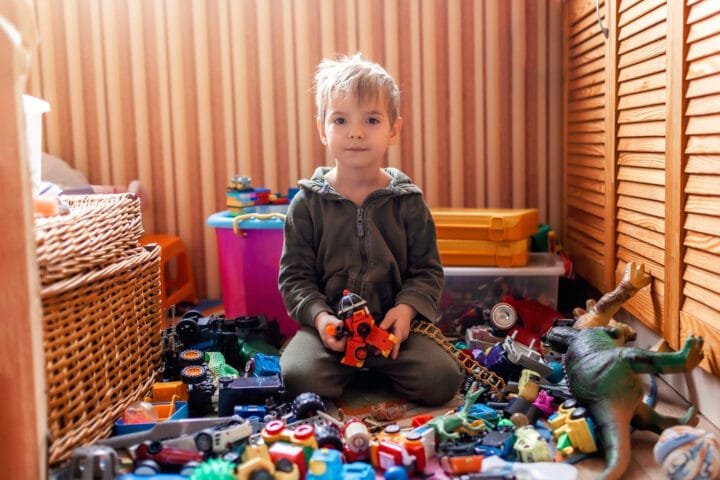Discover the Secret: Your Ultimate Guide to Getting Your Baby to Sleep in a Bassinet Peacefully!
Are you experiencing fatigue due to the baby’s sleep schedule challenges? Imagine the tranquility and comfort of turning bedtime chaos into a calming routine. Picture the moment you gently lay your baby down, and they peacefully drift into restful sleep. While it may seem unattainable at the moment, it is indeed achievable.
Make your dreams a reality using these powerful strategies! Learn this comprehensive guide packed with wisdom and love on how to help your baby rest peacefully in the bassinet. Let go of sleepless nights and welcome peaceful nights and heavenly fantasies for you and your precious one!
Understanding Baby Sleep: The Key to Success
“Getting your baby to sleep in a bassinet” could be challenging. However, it all starts with unraveling infant sleep mysteries. Babies, especially very small ones, require plenty of sleep – around 14-17 hours daily. However, the hours can be interrupted frequently, and exhausted parents think about why their babies like to stay awake all night. Understanding these patterns can give you the control you once had and allow you to better manage your baby’s sleeping.
The Science of Sleep
Babies have shorter sleep cycles than adults. They usually transition between light and deep sleep every 50-60 minutes. Due to this, they may wake up more often during the night as they move between these sleep stages.
The Moro reflex is also one of the most common startle reflexes during the first year of a newborn’s life, which causes an abrupt awakening. This reflex is most noticeable at 2-3 months old and usually diminishes after 6 months.
Understanding these sleep patterns and natural responses can be very helpful for parents who want to help their baby get used to sleeping in a bassinet. This knowledge allows them to more efficiently anticipate and address their baby’s sleep requirements.
Growth Spurts and Development
In the first year of life, infants experience rapid growth and development that can significantly affect their sleeping patterns. The extraordinary growth spurt frequently causes a rise in appetite. This causes infants to get up more frequently because they require more food to support their rapid growth.
Knowing and being aware of the signs that your baby is progressing through these growth phases can provide you with the comfort and reassurance needed on those nights of sleep disturbances.
Creating a Perfect Sleep Environment
Creating a tranquil sleep space is not just a routine job; it’s a crucial responsibility. A calming environment is essential for soothing your child and encouraging healthy sleep habits. It also demonstrates your commitment to your child’s well-being and satisfaction.
Cozy and Comfortable Environment
- Ideal Temperature: Keep the temperature between 68 and 72 degrees F to ensure your child sleeps peacefully. Research has shown that babies sleep more deeply in this zone.
- Safe Bedding: Choose a substantial mattress and an appropriately fitted sheet inside the bassinet to keep your child safe during sleep. Ensuring the bassinet is clear of toys will help everyone get an excellent night’s rest.
Control Light and Noise
- Babies perceive light as a signal to wake up. It is possible to envelop them in darkness as if they were in a comforting womb with blackout curtains.
- Introduce a white noise machine that echoes the rhythmic hum of safety your baby hears during pregnancy. This masks disruptive sounds and lulls them into calm.
A Consistent Routine is Your Best Friend
Consistent routine becomes your unwavering ally regarding “how to get a baby to sleep in a crib or bassinet.” It provides the comfort and predictability your baby dreamer craves at bedtime.
Crafting a Calming Routine
- Start with a Warm Bath: The soothing journey towards sleep begins with the gentle caress of warm water on the skin.
- Bedtime Story or Lullaby: Wrap this in a soft story or sing a lullaby in your loving voice, nurturing feelings of safety and comfort. That dreamtime awaits.
- The “Drowsy but Awake” Principle: Try putting your child in a bassinet and letting their eyes move to teach them how to self-soothe.
Meeting Baby’s Physical Needs
Assuring your infant’s health and well-being is vital to encourage them to sleep in the bassinet. To ensure a tranquil and restful night, you must pay attention to your infant’s health needs to ensure safety, comfort, and peace are crucial for a peaceful and restful sleep.
Feeding and Diapering
- Full, satisfied tummies are paramount. Feed your baby well, but avoid overfeeding, which could cause tossing and turning.
- High-absorbency nighttime diapers are your best friends, keeping your baby dry and comfortable through the dark hours until morning.
Soothing Techniques
- Swaddling: Mimic the womb’s embrace by swaddling to reduce startling and help your baby drift into a deep sleep.
- Winding and Burping: Gently cradling your baby upright after feeding to burp them to combat gas—another villain interrupting precious rest.
Transition Tips: From Arms to Bassinet
The phrase “an infant won’t sleep in a bassinet” is familiar to many parents. Patience, understanding, and gentle persistence are helpful in this transition.
Making the Bassinet Familiar
- Introduce the comforting scent of your favorite shirt nearby (while keeping it out of reach). Familiar scents whisper reassurance to your baby.
- Pre-warm the bassinet with a heating pad or hot water bottle, removing it first. A cozy bed invites your baby more than a cool one does.
Gradual Acclimatization
- Get ready for a fantastic journey! To help your little ones get cozy and confident in their first space, gently introduce them to the bassinet for short, supervised periods during the day. This will help them feel at ease and get used to their updated sleeping spot.
- Start the transition by having your baby take daytime naps in the bassinet. Then, gradually move towards having them sleep there at night, using a gentle and patient approach.
Common Challenges: Addressing Issues Head-On
When figuring out “how to get a baby to sleep in a bassinet,” being prepared for challenges enables flexibility and effective problem-solving.
Handling Nighttime Disturbances
- As they adjust, a few minutes of gentle fussing is nothing to worry about. Practice guided patience when your baby cries in bed.
- For an infant sleeping soundly in your arms but resisting the bassinet, a gradual rock-and-lay strategy eases them into tranquility, like a dance.
Dispelling Sleep Myths
- Introduce solids based on pediatric guidance rather than as a quick sleep fix. Early introductions can disturb digestion and improve sleep.
- Avoid co-sleeping. Trust safe and nurturing sleep practices to guide your baby’s restful nights.
Certainly! Here are revised expert tips for helping your baby sleep in a crib and bassinet:
Mastering Baby Sleep: Getting Beyond the Basics
In your quest to put your baby to rest in a bassinet or crib, it is essential to consider additional measures of comfort in addition to the basics.
1. Pay Attention to Sleep Signals
The indications that your baby is getting ready to sleep, such as rubbing their eyes, being very fussy, or even waking up, are crucial to ensure they get the rest they need.
2. Be patient and flexible
Each baby is unique, so finding the best method to have peaceful sleep may look different for each infant and caregiver. Keeping an open mind and being flexible about this is essential. Adapting to challenges when necessary and being willing to change
3. Nutrition’s Role
Encouraging regular, small feedings during growth spurts is crucial to give your baby an additional source of nourishment without overloading them. Tracking your baby’s nap times during the day will prevent fatigue at night and help them transition smoothly to sleep.
Conclusion: The Journey to Peaceful Sleep
Preparing a child for bedtime can be quite a challenge! Remembering that each child has a unique personality, preferences, and routines is crucial. Therefore, it’s imperative to be both flexible and consistent when establishing a bedtime routine for them.
It’s essential to consider these helpful tips for understanding your child’s sleep patterns! Adapting these approaches to suit your child’s individual needs is crucial. Consistently implementing these techniques is essential for creating a calm and peaceful bedtime environment for your child and yourself.
FAQs
Why won't my baby sleep in the bassinet even when tired?
How can I make my baby sleep longer in the bassinet at night?
Is it normal for my newborn to wake up every few hours?
How long should I keep my baby in a bassinet before transitioning to a crib?
What should I do if my baby only falls asleep while held?
Related Posts



















































































